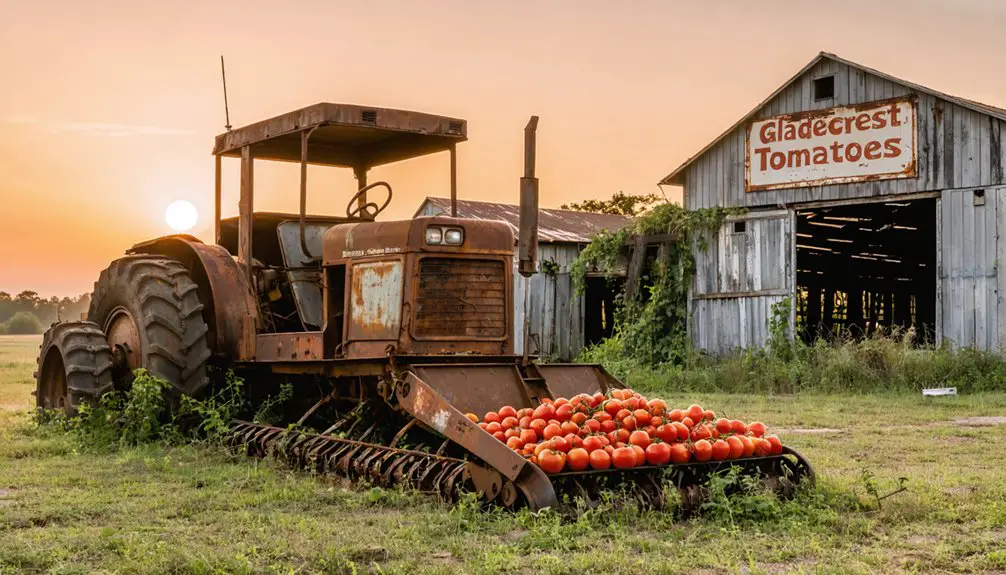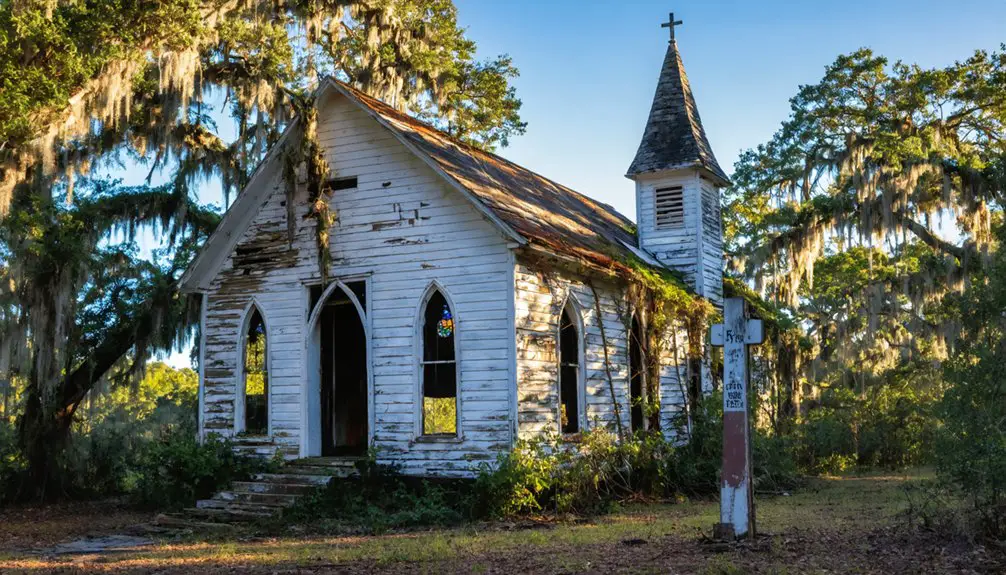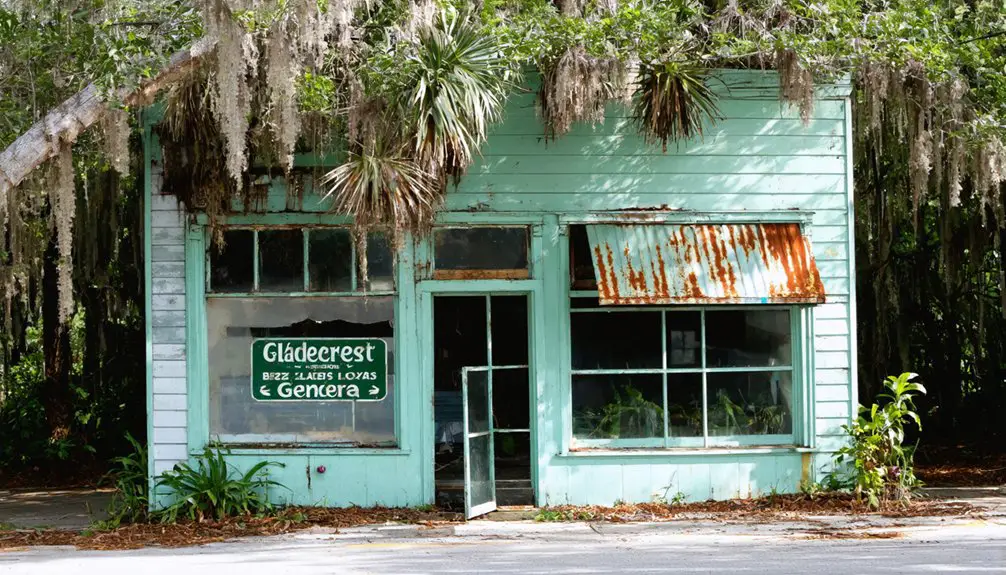You’ll find Gladecrest’s remains near Lake Okeechobee, where hopeful settlers established an agricultural community in 1913. Despite early success with tomatoes, citrus, and sugar cane, the settlement struggled against Florida’s harsh environmental challenges – flooding, mosquitoes, and poor soil conditions. By 1920, only 72 settlers remained, and severe flooding in 1921-22 sealed the town’s fate. Today, this ghost town serves as a compelling window into Florida’s boom-and-bust pioneer era.
Key Takeaways
- Gladecrest was a Florida settlement established in 1913 near Lake Okeechobee that became a ghost town by 1921.
- The community initially thrived on agricultural ambitions but failed due to environmental challenges and difficult farming conditions.
- Severe flooding in winter 1921-22 was the final blow, causing settlers to abandon their homesteads and agricultural activities.
- The settlement featured a post office, schoolhouse, general store, and railroad station before its complete abandonment.
- No buildings or markers remain at the site today, making Gladecrest a true ghost town that disappeared from maps.
The Birth of an Agricultural Dream (1913-1915)
Pioneering farmers flocked to Gladecrest in 1913 as part of Florida’s ambitious agricultural expansion into the Everglades region. You’d have found these early settlers transforming challenging wetlands into productive farmland, armed with determination and agricultural innovations. Their efforts quickly paid off at the Palm Beach County Fair, where local produce earned recognition and prizes.
The area’s initial success centered on pineapples, but you’d also see thriving citrus groves, mango orchards, and tomato fields dotting the landscape. The wetland transformations weren’t easy – farmers battled persistent drainage issues and complex soil conditions. The Internal Improvement Fund helped manage the public lands and coordinate infrastructure development.
Early Settlers and Town Founders
While specific names of Gladecrest’s founders haven’t survived in historical records, you’ll find the Holland and Butterworth Company played the central role in establishing and promoting the settlement to prospective buyers in the early 1910s.
The company’s aggressive marketing campaign drew dozens of pioneer families who purchased land sight unseen, believing they could sustain themselves through year-round farming. Like the successful pineapple plantations that flourished in nearby Viking, many hoped to establish profitable agricultural ventures.
Similar to many settlements established during Florida’s early 1900s boom, the town’s optimistic vision of agricultural prosperity ultimately failed to materialize.
Pioneer Families and Leaders
As land promoters Holland & Butterworth Company launched their ambitious sales campaign in 1913, roughly twenty pioneering settlers established Gladecrest near the Hillsboro Canal area, south of Lake Okeechobee.
You’ll find that these early families displayed remarkable pioneer resilience as they attempted to cultivate crops in the challenging sawgrass soil, though their efforts ultimately proved futile.
The settlement’s leadership emerged organically from the homesteading families, who focused on community adaptation through informal organization and shared agricultural practices.
While specific leaders aren’t documented, these determined pioneers worked together to build basic infrastructure and maintain their fledgling town until their peak population reached 72 by spring of 1915.
Similar to High Coria’s experience, local wildlife sightings included panthers and other predators that the settlers had to contend with.
Holland & Butterworth’s Vision
In 1915, the Holland & Butterworth Company launched their ambitious vision for Gladecrest by selling plots of land along the Hillsboro Canal south of Lake Okeechobee. Their land speculation venture marketed the promise that a single acre could sustain an entire family through farming, drawing settlers to this new agricultural frontier. Like many settlers in early Florida, they established Radio Club Cerro to build community connections.
Like many towns in Palm Beach County, Gladecrest faced severe destruction from the 1928 hurricane. You’ll find their vision was typical of early 20th-century Florida development schemes, focusing on small-scale family farms rather than large commercial operations. They’d planned for essential services, stores, and transport access via the canal.
However, agricultural limitations soon revealed the harsh reality – their claims about one-acre farm viability didn’t match the challenging environmental conditions. Despite reaching 72 residents at its peak, the settlement couldn’t overcome persistent flooding and poor soil quality, leading to Gladecrest’s abandonment by 1921.
Life in the Pioneer Settlement
You’d find daily life in Gladecrest centered around labor-intensive sugar cane farming and charcoal production, with families working from sunrise to sunset alongside servants and hired hands.
The settlement’s roughly ten households faced typical pioneer challenges, including the demanding tasks of washing clothes in iron pots, maintaining livestock, and hauling 100-pound sacks of charcoal to market. Similar to other living history sites like the Panhandle Pioneer Settlement, residents preserved traditional skills through hands-on demonstrations. Educational classes in broom making and canning helped sustain essential household crafts.
The community’s social fabric was strengthened through their shared post office, one-room schoolhouse, and regular church gatherings, where residents could briefly escape their demanding agricultural routines.
Daily Pioneer Routines
Life in Gladecrest’s pioneer settlement demanded rigorous daily routines centered around basic survival needs. You’d start your day by fetching water from wells or creeks, then tend to the wood-burning stove for breakfast preparation.
Pioneer chores filled your mornings with clothes washing on washboards, floor scrubbing, and maintaining essential tools. Traditional skills like blacksmithing and quilting were taught to preserve essential crafts for the community.
As the day progressed, you’d tackle food preservation tasks like churning butter, despite Florida’s challenging heat, or making preserves from local fruits. You’d need to craft candles from beeswax or animal fat to light your evenings.
Community support proved crucial, as you’d often exchange labor with neighbors for tasks like repairs or building maintenance.
Children attended the simple Shiloh Schoolhouse while adults maintained the settlement’s basic infrastructure using just hand tools and determination.
Farming Community Challenges
Despite Holland and Butterworth Company’s ambitious marketing claims, Gladecrest’s settlers quickly discovered harsh agricultural realities that would doom their farming dreams. You’d have struggled to make the sawgrass peat soil yield anything beyond its namesake, with vegetables yellowing and dying despite various farming techniques. The company’s promise that one acre could feed a family with four annual harvests proved devastatingly false.
Your community resilience would’ve been tested by relentless environmental challenges. You’d have battled persistent mosquitoes, endured seasonal flooding, and faced crop failures in the harsh climate. The isolation and poor infrastructure only compounded these difficulties.
Social Life and Business
While settlers grappled with farming hardships, Gladecrest’s social fabric revolved around a network of tight-knit families who supported each other through daily challenges.
You’d find community gatherings centered around the local post office and general store, where merchant networks facilitated crucial trade of goods and services. These hubs became the heartbeat of pioneer life, connecting scattered households through commerce and communication.
- Small-scale traders, craftsmen, and farmers worked multiple roles to sustain their families.
- Religious meetings and social events strengthened community bonds in shared spaces.
- Local merchants provided indispensable supplies while creating gathering spots for news and fellowship.
Life in Gladecrest demanded resourcefulness – you’d often see families combining their skills in farming, fishing, and hunting to make ends meet, while maintaining strong social connections through regular communal activities.
Tomato Farming and Economic Growth

As commercial agriculture took root in Florida during the 1870s, tomato farming emerged as a transformative force in Gladecrest’s economy.
You’d find local farmers experimenting with tomato cultivation in the early 1900s, after drainage projects made the land workable.
While they initially struggled with the muck soil, they discovered that adding hardwood ash greatly improved their yields.
Environmental Challenges and Natural Obstacles
The environmental obstacles facing Gladecrest proved far more challenging than the agricultural difficulties farmers had encountered with their tomato crops.
You’ll find that the town’s location made it particularly vulnerable to environmental degradation, with flooding risks becoming increasingly severe due to altered drainage patterns and inadequate flood control measures.
- Sea air and high humidity accelerated the decay of buildings and infrastructure
- Dense vegetation, including saw palmettos and scrub pines, rapidly reclaimed cleared land
- Hurricanes repeatedly devastated both structures and natural flora
The combination of these natural forces made it nearly impossible to maintain viable settlements.
The engineering of dikes and ditches offered only temporary relief, while the corrosive effects of sea air and aggressive plant growth continued to undermine human attempts to tame the landscape.
Weather events ultimately hastened Gladecrest’s abandonment.
The People Behind Gladecrest’s Development

Despite grand promises of agricultural prosperity, the Holland and Butterworth Company launched Gladecrest’s development in late 1913 through aggressive marketing campaigns that targeted prospective farmers with unrealistic claims.
Their development strategies focused on selling one-acre plots sight unseen, with enticing but false promises of frost-free conditions and mosquito-free environments.
Settler motivations centered on the dream of affordable farmland and the company’s claims that the soil could support four crops annually.
You’ll find that most early residents were farmers and laborers who invested their hopes and savings in these plots.
However, the developers’ deceptive practices quickly unraveled as settlers discovered the land’s true nature – soil that could only sustain sawgrass, not the promised vegetable crops that would’ve supported their families.
Business and Commerce in Early Days
You’ll find that Gladecrest’s early business district centered around essential services, including a general store, post office, and the AAA gas station with its distinctive outhouse facility.
The town’s commercial growth was closely tied to the railroad station, which offered overnight accommodations for travelers and helped facilitate regional trade.
Local businesses adapted to changing times, as evidenced by the addition of fax services at the gas station and the creative repurposing of historic buildings like the old jail and cypress-wood post office into retail spaces.
Main Street Merchant Activity
While Gladecrest’s commercial landscape remained modest throughout its brief existence, Main Street featured several small merchant storefronts that served the fledgling farming community during its 1915 peak.
Despite initial commercial optimism, you’d find these businesses focused primarily on basic provisions and general merchandise.
Key aspects of Main Street’s merchant activity included:
- Local stores serving as both supply centers and social gathering spots
- Business operations dependent on nearby farming families
- Merchant resilience tested by declining agricultural output
The town’s commercial core never expanded beyond these essential services, as poor soil conditions and failed crops gradually eroded the economic foundation.
Early Business Pioneers
As Main Street’s merchant scene faded, a broader group of business pioneers had already laid the groundwork for commerce throughout the region. Pioneer entrepreneurs like John J. Hinson established vital outposts, operating Kendall’s first post office in 1914 and serving both settlers and Seminole populations.
You’ll find early commerce was shaped by harsh transportation realities, with only sturdy Studebaker wagons able to navigate the rough trails to towns like Cutler. Savvy businessmen positioned their enterprises 15 miles south of Miami to better serve South Dade markets.
The Model Land Company, created by Henry Flagler in 1896, drove commercial development by promoting town lots and agricultural land. Later, ambitious developers like George Edgar Merrick and Richard H. Rice continued transforming wild lands into planned communities, despite the challenging terrain.
Local Trade and Services
Despite early promotional claims about Gladecrest’s commercial potential, the settlement’s trade infrastructure remained primitive throughout its brief existence.
You’d have found basic two-wheel drive roads and canal routes that connected to nearby towns, but permanent commercial structures were conspicuously absent.
The settlement’s trade limitations were evident in:
- Small general stores and traveling merchants providing only basic necessities
- Local barter systems emerging due to unreliable crop yields
- Dependency on nearby towns for specialized goods and services
The Final Years (1920-1922)
Although Gladecrest had attracted roughly 72 settlers by 1920, the small farming community’s final years would prove catastrophic.
Despite their agricultural aspirations, the settlers faced mounting challenges that would ultimately shatter their dreams of prosperity. The winter of 1921-22 delivered the final blow, as severe flooding decimated crops and forced families to abandon their homesteads.
Community resilience was tested as the few remaining businesses, including a small drug store and general stores, struggled to serve the dwindling population. High water levels made farming impossible, and the lack of adequate infrastructure left settlers with no means to combat the environmental challenges.
Legacy in Florida’s Lost Communities

While many Florida ghost towns have faded into obscurity, Gladecrest’s story stands as a compelling example of early 20th-century settlement failures.
Today, you’ll find no trace of this lost community among the vast sugarcane fields of Palm Beach County, yet its cultural memory endures through historical maps and documented accounts.
- The town’s complete disappearance reflects a broader pattern of ghost town preservation challenges in Florida.
- You can trace Gladecrest’s existence on the 1921 LL Poates Co. Florida Map, marking its final documented presence.
- The site serves as a representation of the risks early settlers faced when pursuing agricultural dreams in Florida’s challenging environment.
Gladecrest’s legacy reminds you that Florida’s landscape is dotted with similar “intervals of neglect,” where ambitious communities once flourished before succumbing to environmental and economic realities.
Historical Significance and Modern Remnants
The transformation of Gladecrest from a hopeful settlement to barren sugarcane fields tells a stark tale of Florida’s land speculation era.
You’ll find no traces of the community that once dreamed of agricultural prosperity here – just endless rows of sugarcane where 72 settlers once lived and worked.
The settlement’s failure serves as a cautionary example of early 20th-century development schemes. From its founding in 1913 to its agricultural decline by 1915, Gladecrest’s story mirrors many Florida communities that fell victim to misleading land promotions.
Today, you won’t see any buildings or markers at the site near Lake Okeechobee, though it appears on 1921 maps. The town’s complete disappearance by 1921 after flooding makes it a true ghost town, reflecting the harsh realities of Florida’s boom-and-bust cycles.
Frequently Asked Questions
What Happened to the Buildings and Structures After the Town Was Abandoned?
Like fallen giants, abandoned architecture crumbled as nature reclaimed the town. You’d find urban decay taking hold – weather damage, structural collapses, and scavengers removing materials for reuse elsewhere.
Were There Any Schools or Churches Established During Gladecrest’s Existence?
You won’t find any school history or church significance during this town’s brief existence – records show no educational or religious institutions were ever established between 1913-1921.
How Did Residents Get Their Drinking Water in Gladecrest?
You’d get your drinking water primarily from hand-dug or machine-drilled wells, using pumps to draw groundwater. You might’ve supplemented this with rain harvesting, though you’d need to boil both sources.
What Forms of Transportation Connected Gladecrest to Neighboring Communities?
While you’d think a remote town was isolated, you weren’t – the Atlantic Coast Line Railroad connected you to everywhere, and Conners Highway linked you to neighboring communities by the 1920s.
Did Any Notable Events or Celebrations Take Place in Gladecrest?
You won’t find any ghostly festivals or historical reenactments documented there – no notable celebrations took place during its brief existence from 1913-1921, as settlers quickly abandoned the struggling farming community.
References
- https://www.journaloffloridastudies.org/0102ghosttowns.html
- https://palmbeachpast.org/2011/03/palm-beach-countys-lost-towns-the-complete-list/
- http://www.gribblenation.org/2018/08/ghost-town-tuesday-ghost-towns-of-lake.html
- https://www.ghosttowns.com/states/fl/gladecrest.html
- https://www.youtube.com/watch?v=ov9YSsKtbDs
- https://delraybeachhistory.org/blog/the-delray-affairs-deep-roots-the-agricultural-development-of-delray-beach-and-the-gladioli-festival/
- https://flaglercountyhistoricalsociety.com/wp-content/uploads/2020/08/Florida-New-Deal.pdf
- https://evergladeswildernessontheedge.com/wp-content/uploads/2017/05/chap-1.pdf
- https://freepages.history.rootsweb.com/~gtusa/usa/fl.htm
- https://www.youtube.com/watch?v=TxBONhwNi1k



